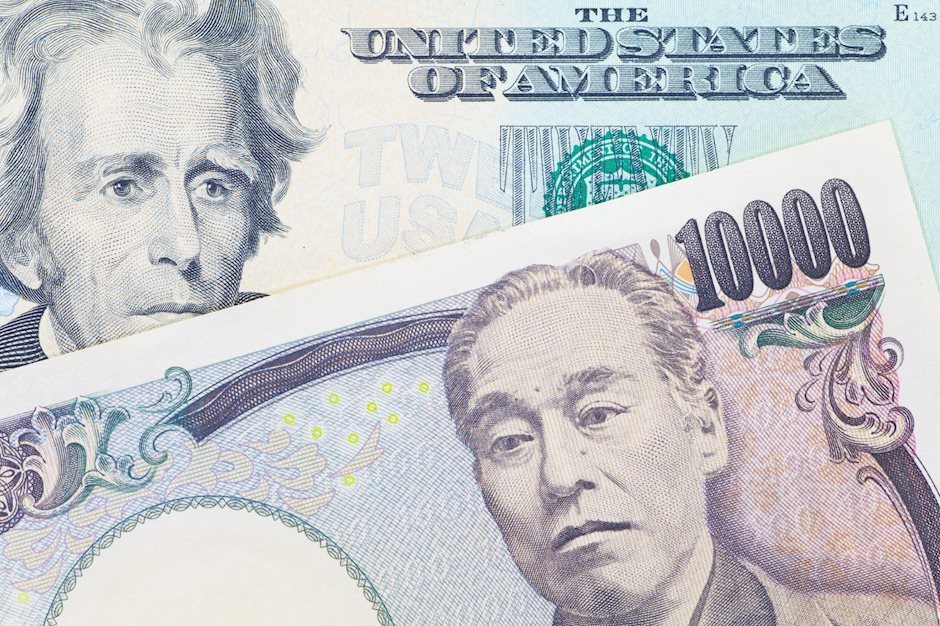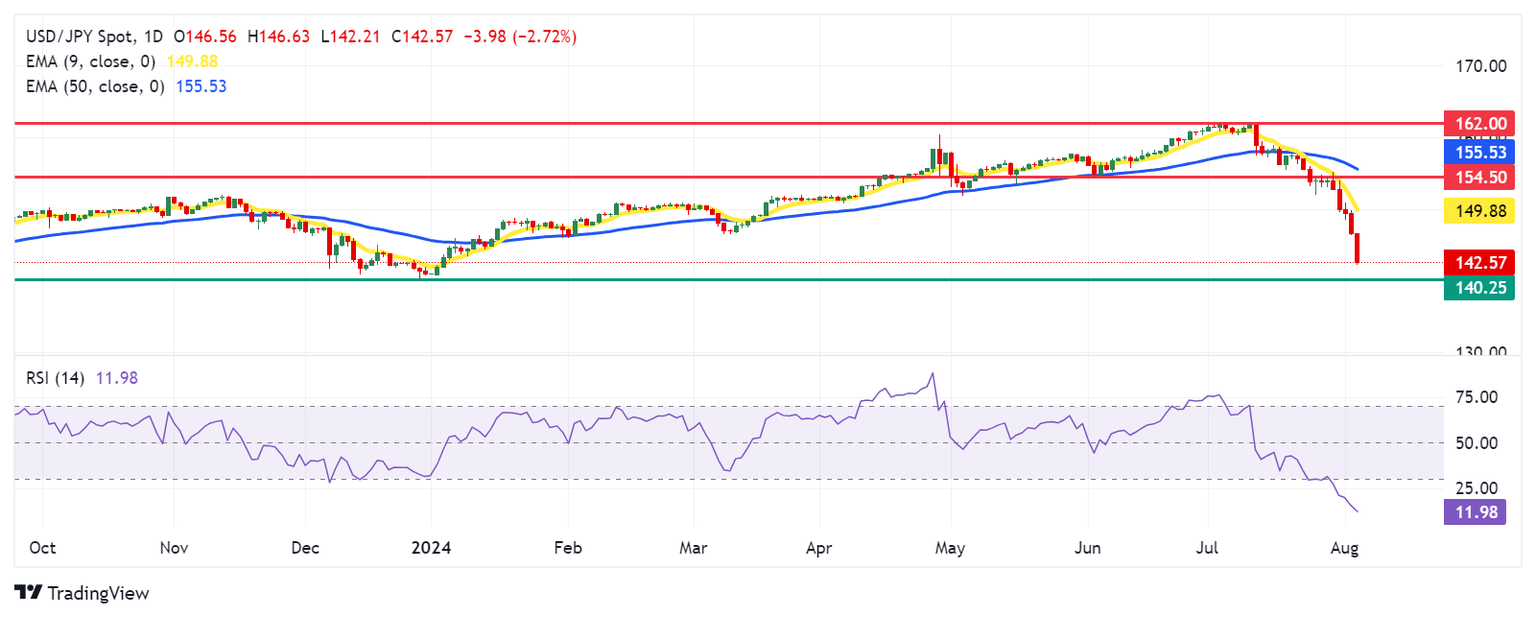Japanese Yen extends upside due to risk-off flows, US Services PMI eyed
- The Japanese Yen extends its winning streak due to heightened expectations of further rate hikes by the BoJ.
- The JPY receives support from safe-haven flows due to escalated geopolitical tensions in the Middle East.
- Recent US labor data increased the probability of a 50-basis point Fed rate cut to 74.5% in September.

The Japanese Yen (JPY) extends its winning streak against the US Dollar (USD) for the fifth successive session on Monday. This momentum is supported by expectations that the Bank of Japan (BoJ) may further tighten monetary policy, along with the unwinding of carry trades, which could provide continued support for the JPY in the near term.
The safe-haven Yen could benefit from heightened geopolitical tensions in the Middle East. An Israeli airstrike on Sunday hit two schools, resulting in at least 30 casualties, according to Reuters. Additionally, US Secretary of State Tony Blinken indicated that Iran and Hezbollah might launch an attack against Israel as early as Monday, based on information from three sources briefed on the call, as reported by Axios.
The US Dollar faces pressure following Friday’s disappointing labor market data, which strengthened expectations for a US Federal Reserve interest rate cut in September. The CME's FedWatch Tool now indicates a 74.5% probability of a 50-basis point rate cut on September 18, up from 11.5% a week prior.
Daily Digest Market Movers: Japanese Yen appreciates as odds of Fed rate cuts increase
- The minutes from the Bank of Japan's June meeting showed that some members expressed concerns about rising import prices due to the recent decline in the JPY, which could pose an upside risk to inflation. One member noted that cost-push inflation might intensify underlying inflation if it results in higher inflation expectations and wage increases.
- US Nonfarm Payrolls (NFP) increased by 114K in July from the previous month of 179K (revised down from 206K). This figure came in weaker than the expectation of 175K, data showed on Friday. Meanwhile, the US Unemployment Rate rose to the highest level since November 2021, coming in at 4.3% in July from 4.1% in June.
- The Bank of Japan (BoJ) released the full version of its Quarterly Outlook Report on Thursday, noting that there is a possibility wages and inflation could exceed expectations. This could be accompanied by rising inflation expectations and a tight labor market.
- Japan’s Chief Cabinet Secretary Yoshimasa Hayashi stated on Thursday that currencies must move steadily and reflect their underlying fundamentals. Hayashi refrained from commenting on specific forex levels but noted that he is closely monitoring foreign exchange movements, per Reuters.
- Reuters reported on Wednesday that Japan’s Ministry of Finance confirmed suspicions of market intervention by authorities. In July, Japanese officials spent ¥5.53 trillion ($36.8 billion) to stabilize the Yen, which had fallen to its lowest level in 38 years.
- BoJ Governor Kazuo Ueda deemed it appropriate to adjust the degree of easing to sustainably and stably achieve the 2% inflation target. Additionally, he emphasized that they will keep raising interest rates. Moreover, Japan's largest lender Mitsubishi UFJ Bank announced that it will raise its short-term prime lending rate to 1.625% from 1.475% starting from September 2, aligning with the BoJ’s rate hike, per Reuters.
- Assessing the BoJ's policy outlook moving forward, "the BoJ’s policy statement includes a fairly optimistic assessment of the Japanese economic outlook stating that fixed investment is ‘on a moderate increasing trend’ and corporate profits are ‘improving’," said Rabobank analysts and added: "It states that wage rises ‘have been spreading across regions, industries, and firm sizes.’ This leaves the door open for further rate hikes potentially in late 2024 or early 2025."
Technical Analysis: USD/JPY falls to near 142.00
USD/JPY trades around 142.00 on Monday. The daily chart analysis shows that the pair is continuing its losing streak. The 14-day Relative Strength Index (RSI) is moving below 30, suggesting an oversold currency asset situation and a potential short-term rebound.
The USD/JPY pair navigates the region around lows since December 2023. The pair may test the throwback support at the 140.25 level.
On the upside, the USD/JPY pair might encounter resistance around the nine-day Exponential Moving Average (EMA) at 150.13. A break above this level could weaken the bearish bias and support the pair to test the "throwback support turned resistance" at 154.50, followed by the 50-day EMA at 155.58 level.
USD/JPY: Daily Chart
Japanese Yen PRICE Today
The table below shows the percentage change of Japanese Yen (JPY) against listed major currencies today. Japanese Yen was the strongest against the Australian Dollar.
| USD | EUR | GBP | JPY | CAD | AUD | NZD | CHF | |
|---|---|---|---|---|---|---|---|---|
| USD | -0.53% | -0.04% | -2.61% | 0.01% | 1.09% | 0.52% | -1.04% | |
| EUR | 0.53% | 0.41% | -2.24% | 0.42% | 1.62% | 0.94% | -0.63% | |
| GBP | 0.04% | -0.41% | -2.54% | 0.02% | 1.21% | 0.53% | -1.04% | |
| JPY | 2.61% | 2.24% | 2.54% | 2.76% | 3.76% | 3.26% | 1.66% | |
| CAD | -0.01% | -0.42% | -0.02% | -2.76% | 1.11% | 0.51% | -1.24% | |
| AUD | -1.09% | -1.62% | -1.21% | -3.76% | -1.11% | -0.68% | -2.07% | |
| NZD | -0.52% | -0.94% | -0.53% | -3.26% | -0.51% | 0.68% | -1.56% | |
| CHF | 1.04% | 0.63% | 1.04% | -1.66% | 1.24% | 2.07% | 1.56% |
The heat map shows percentage changes of major currencies against each other. The base currency is picked from the left column, while the quote currency is picked from the top row. For example, if you pick the Japanese Yen from the left column and move along the horizontal line to the US Dollar, the percentage change displayed in the box will represent JPY (base)/USD (quote).
Interest rates FAQs
Interest rates are charged by financial institutions on loans to borrowers and are paid as interest to savers and depositors. They are influenced by base lending rates, which are set by central banks in response to changes in the economy. Central banks normally have a mandate to ensure price stability, which in most cases means targeting a core inflation rate of around 2%. If inflation falls below target the central bank may cut base lending rates, with a view to stimulating lending and boosting the economy. If inflation rises substantially above 2% it normally results in the central bank raising base lending rates in an attempt to lower inflation.
Higher interest rates generally help strengthen a country’s currency as they make it a more attractive place for global investors to park their money.
Higher interest rates overall weigh on the price of Gold because they increase the opportunity cost of holding Gold instead of investing in an interest-bearing asset or placing cash in the bank. If interest rates are high that usually pushes up the price of the US Dollar (USD), and since Gold is priced in Dollars, this has the effect of lowering the price of Gold.
The Fed funds rate is the overnight rate at which US banks lend to each other. It is the oft-quoted headline rate set by the Federal Reserve at its FOMC meetings. It is set as a range, for example 4.75%-5.00%, though the upper limit (in that case 5.00%) is the quoted figure. Market expectations for future Fed funds rate are tracked by the CME FedWatch tool, which shapes how many financial markets behave in anticipation of future Federal Reserve monetary policy decisions.
Author

Akhtar Faruqui
FXStreet
Akhtar Faruqui is a Forex Analyst based in New Delhi, India. With a keen eye for market trends and a passion for dissecting complex financial dynamics, he is dedicated to delivering accurate and insightful Forex news and analysis.


















